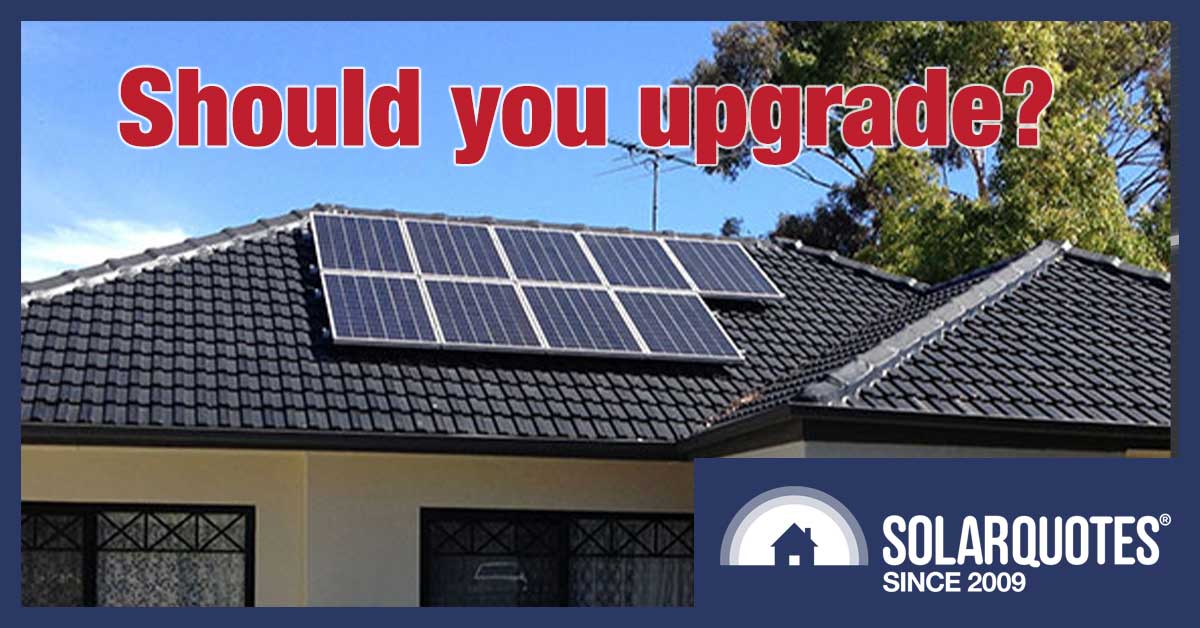
If you have a small, old system, replacing it with a bigger, more efficient modern system is worth serious consideration. Even if it means losing that premium feed-in-tariff you’ve enjoyed for all these years.
Do you have a faithful, old, 1.5 kilowatt solar system installed?
Has it sat on your roof churning photons into electrical energy for 10 years or more?
Has it earned you a heap of money because it gets an old, premium feed-in tariff far higher than anything available now?
If so, congratulations! It’s been a loyal and valuable addition to your household and has likely earned you much more than the massive amount you probably paid for it.
But, if you want to make more money, odds are you should scrap that small old system and replace it with a new larger installation. In Adelaide and Darwin, you’re almost certain to come out ahead, while in Canberra, Brisbane, and Melbourne it can still pay – provided your solar self-consumption and daytime electricity use is average or higher.
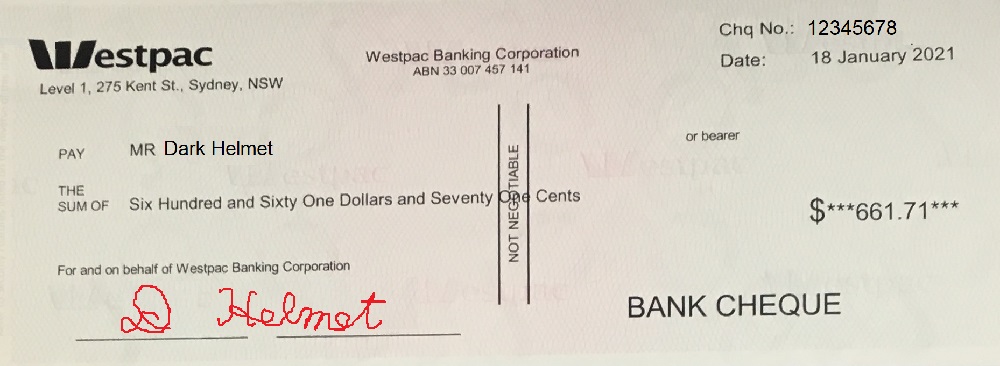
The usual ways to get a large annual credit on your electricity bills is to either have a reasonably large solar system or small system and a locked-in large feed-in tariff.
2 kW is the magic number for premium feed-in-tariffs
If a solar system is over 2 kilowatts and receiving a high feed-in tariff, then replacing it is unlikely to save money unless your daytime electricity consumption is high or you are willing to make an effort to shift your electricity consumption to the day.
But even if your electricity consumption isn’t high, if you consider the atmosphere’s energy balance to be more important than your bank balance, you may want to get a larger system anyway.
Where Are The Remaining High Feed-In Tariffs?
Three years ago I wrote about if replacing small old solar power systems receiving high feed-in tariffs made financial sense and concluded it often didn’t. But times have changed and an up-to-date article is called for.
Since I wrote my previous article the high feed-in tariffs have come to an end in NSW and Tasmania. This leaves three states and two territories where they’re still around. Western Australia’s has already mostly finished and will be completely over by July. As far as this article is concerned, I’m going to regard their jacked-up tariff as over.
The remaining locations where old solar systems are still receiving big fat, locked-in, feed-in tariffs are:
- The ACT
- The Northern Territory
- Queensland
- South Australia
- Victoria
If you have an old solar power system installation of around 1.5 kilowatts in any location that doesn’t receive a high feed-in tariff it will normally make financial sense to replace it with a new larger system, no matter where you are. The possible exception is Western Australia where households with low electricity consumption may be better off sticking with a small system due to the low feed-in tariffs available for new solar in that state.
How Much Are Those Old Tariffs?
Since states and territory use different terminology, I’m simply going to call them Premium Feed-in Tariffs. I can’t just refer to them as old and high and making lots of money because that brings up bad connotations.
The remaining Premium Feed-in Tariffs that will be around for more than a few months are:
- The ACT: A 45 cent gross tariff for every kilowatt-hour generated regardless of how little or how much electricity the home consumes. Lasts 20 years and the final ones will end in 2031.
- The Northern Territory: Equal to the per-kilowatt-hour charge for grid electricity and currently 26 cents. No end point given so far.
- Queensland: 44 cents + retailer tariff. Can easily total over 50 cents. Ends 1st July 2028.
- South Australia: 44 cents + retailer tariff. Can total over 55 cents. Ends 1st July 2028.
- Victoria: 60 cents + retailer tariff. Can total over 70 cents. Ends in late 2024.
As you can see, Victoria has one hell of a Premium Feed-in Tariff. Unfortunately for those in Melbourne, that city has the lowest solar output of any mainland location.
Annual Savings With Premium Feed-in Tariff & Without
Luckily for me, the SolarQuotes Solar & Battery Calculator makes it very easy to find the expected annual electricity bill savings from a 1.5 kilowatt system with a Premium Feed-in Tariff and compare it to what would be received by replacing it with a larger solar system. In this case, I am going to look at a 6.6 kilowatt solar system because it’s a commonly installed system size, but this doesn’t mean you shouldn’t consider a larger system.
Taking into account…
- Your budget
- Roof space, and…
- What you are permitted to install
It will often make sense to go larger than 6.6 kilowatts, even if it’s necessary to export limit your solar system.
The graph below contrasts annual electricity bill savings from two very different solar panel systems:
- A 1.5 kilowatt, north-facing system, receiving a Premium Feed-in Tariff that has suffered no significant deterioration in output since it was installed, and…
- A new 6.6 kilowatt, north-facing solar system installation, receiving a current feed-in tariff.
As you can see, the savings in each capital1 from a 6.6 kilowatt solar power system with a current feed-in tariff clearly exceed those from a 1.5 kilowatt solar system with a Premium Feed-in Tariff.
If I make a graph just showing how much more a 6.6 kilowatt system saves compared to a 1.5 kilowatt system with a Premium Feed-in Tariff over a year, it looks like this:
The difference is clearly greatest in Adelaide and least in Melbourne. However, as the graph’s title suggests, a lot has been left out and it’s far from being a fair comparison.
Not The Full Story
While it would be nice and easy to end the article here, there are a number of other factors that need to be considered. The five main ones are:
- The cost of capital
- Wear and tear on the new system
- Declining feed-in tariffs and electricity prices
- Deterioration of solar systems
- Solar self consumption
I’ll go over all of these, but first I’ll consider what a new solar panel system install is likely to cost.
Solar System Cost
Having a large, brand new, solar system installed on your roof is a pretty good idea. Not only will it reduce or potentially eliminate your electricity bills by providing clean energy, but it will also help keep your home cool and protect your roof. The only real disadvantage is it costs money.
The good news here is systems with reliable hardware can be bought from installers who do high-quality work at very reasonable costs these days. So long as you’re not beyond the black stump and don’t have a roof that’s difficult to install on, it’s possible to get a quality 6.6 kilowatt system for under $5,000.
This won’t pay for the best components available, but it will pay for solar panels that will last for decades and an inverter that will operate for over ten years. Provided you’re careful and do your research, you can avoid dodgy installers and find someone who does high-quality work. Or you could get quotes from installers through us.
Cost Of Capital
Money has a cost. This can be the interest when you borrow it or the return you could have received from investing it.
If you borrow $5,000 to pay for a new solar system, the cost of capital is easy to work out, as it’s equal to the loan’s interest rate. But if you don’t borrow and pay with money you already have, the cost of capital is equal to the rate of return of whatever investment you would have otherwise made using that money. If you would have used it to pay off a home loan at 3% then it’s 3%. If you’d instead spend it on getting a bunch of nuts into a tub full of whiskey and egg whites, you can determine for yourself what kind of return that gives you.

These Pecan Whiskey Meringues are nuts. Recipe here. (Image Source: Diary of a Mad Hausfrau.)
If you could have instead invested the money at 5% then a $5,000 solar system will cost you the $250 a year you could have made from that investment.
Because interest rates are low, I’ll assume a rate of 4%, which comes to $200 a year for a $5,000 system installation. But someone who is a brilliant investor or owes money to the mafia may consider double that to be a more appropriate rate. If $200 is subtracted from the annual net benefit from a 6.6 kilowatt system to account for the cost of capital, then a new system is still worthwhile in all the locations:
Wear & Tear
If you currently have an old, small, solar system installed on your roof, it will suffer wear and tear. That’s unavoidable as it’s out in the elements being fried by the sun and soaked by rain. The only way to stop it is to scrap it. But replacing it with a new system is a choice you can put off. And deciding not to install a new system until your Premium Feed-in Tariff ends delays the start of wear and tear on it and pushes the need to eventually replace the new system further into the future.
Just how much to allow for wear and tear and a system’s eventual need for replacement is difficult to determine. I expect quality modern solar power systems will last over 30 years2 and will cost significantly less to replace that far in the future. But many people won’t stay in one location for that long, which complicates the issue.
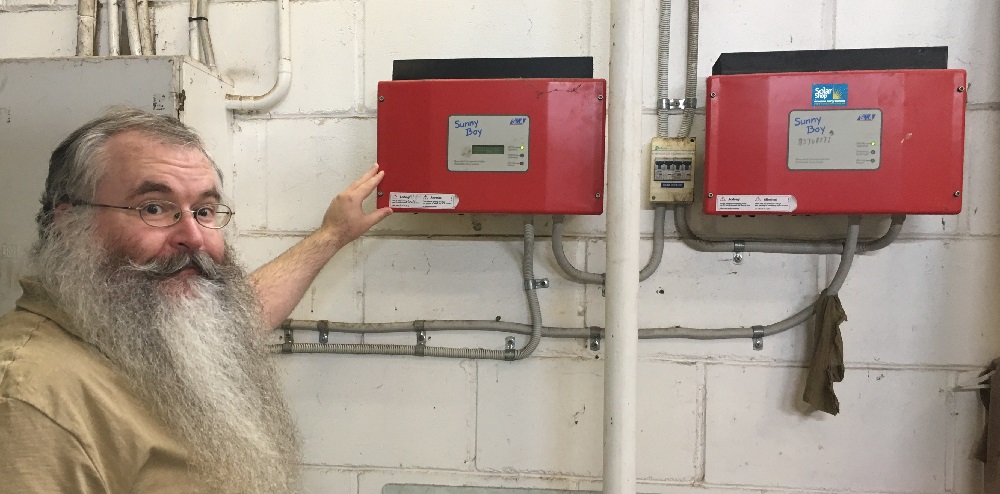
These SMA Sunny Boy inverters are part of one of the oldest solar installations in Adelaide, so everything in this photo is old. One inverter has operated for 21 years while the other was added a few years later when the system was expanded. The fact they’re still going strong is an impressive display of reliability. Update 1 March 2021: I have since been told the inverters were replaced in 2005 because the system was expanded, so they are actually only 16 years old. I thought they didn’t look 21 years old. They’re still an impressive age, but not as impressive as I thought.
To keep it simple, I’ll allow $125 for wear and tear per year. I’m keeping everything in today’s money, so after 20 years this will come to $2,500 to replace the system if necessary at that point. It may be optimistic to assume that much will be enough, given that STCS that lower the cost of rooftop solar will be gradually reduced to nothing over the next 10 years, but 20 years ago a 4.5 kilowatt system was around $45,000 in today’s money. Hence, a price drop of 50% isn’t extreme compared to what has happened over the previous 20 years.
If $125 a year to account for wear and tear is added on top of $200 for the cost of capital, then a new 6.6 kilowatt system installation comes out this much ahead per year over a 1.5 kilowatt system with a Premium Feed-in Tariff:
A new system still comes out ahead in all the locations, but Melbourne’s looking a bit ropey.
Declining Feed-in Tariffs & Electricity Prices
Solar feed-in tariffs won’t disappear anytime soon, but their general direction is heading downwards as solar capacity increases. The lower current solar feed-in tariffs get, the greater the value there is from keeping an old system with a high Premium Feed-in Tariff. Electricity prices are also falling and reducing the return from rooftop solar.
To allow for this, I’m going to reduce the current feed-in tariffs given by the SolarQuotes Solar & Battery Calculator by 20% and the per-kilowatt-hour charges for grid electricity by 10%.
Both Canberra and Melbourne are now slightly in the red. But things will look better if we take into account that older systems will have some deterioration in output and their inverters were generally less efficient.
System Deterioration
It’s an unfortunate fact solar systems slowly decline in output over time. Unless, of course, the panels are crap. In this case, the decline can be rapid and serious problems or total failure can occur within a few years. While the problem isn’t as bad today, a lot of crap solar panels installed in the past, so some old 1.5 kilowatt systems now only provide a fraction of the output they should.
But I am going to ignore the crap ones and only consider systems with good quality panels that have only suffered mild deterioration. I’m going to assume these 1.5 kilowatt systems that are now mostly 10 or 11 years old have only had their output reduced by 5%.
Another factor that isn’t deterioration, but I’ll include here, is that modern inverters are more efficient than they were in the past. Also, larger inverters tend to be slightly more efficient than smaller ones. To account for this, I’m going to increase the deterioration due to age by 3% up to 8%. This gives:
So after accounting for capital costs, wear and tear, falling electricity prices and feed-in tariffs, and system deterioration plus lower inverter efficiency, then — provided the assumptions I’ve used are reasonable for your circumstances — it looks like replacing an old 1.5 kilowatt solar panel system receiving a Premium Feed-in Tariff with a 6.6 kilowatt or larger system installation is likely to make financial sense in all the locations. But this will only hold for households with average electricity consumption and solar self-consumption, because those are the defaults the SolarQuotes Solar & Battery Calculator uses.
Systems Over 1.5 kW & Premium Tariffs
So far I’ve focused on 1.5 kilowatt solar systems and there’s a good reason for that. Due to the way incentives used to work, that is by far the most common system size receiving a Premium Feed-in Tariff. But there is variation. Some were only one kilowatt while others were two or three kilowatts. Some enthusiastic people with deep pockets even went as far as installing 5 kilowatt systems. These were regarded as absolutely massive back then, but I now consider them undersized for most households.
Provided it’s still working acceptably, the larger the solar power system receiving a Premium Feed-in Tariff, the less likely it is to make financial sense to replace it with a new larger system. Just going from 1.5 to 2 kilowatts makes a big difference, as the following graph shows. It the same as the previous graph, but for a 2 kilowatt system:
As you can see, only in Darwin and Adelaide does it make sense to replace a 2 kilowatt system with a Premium feed-in tariff. If a solar system is 3 kilowatts or larger and receiving a Premium Feed-in Tariff then it won’t make financial sense to replace it with a 6.6 kilowatt new system installation anywhere.
Solar Self Consumption
Normally the larger the percentage of solar energy your home consumes the better the return on the system. This is because the cost of grid electricity is much higher than modern feed-in tariffs. But the old Premium Feed-in Tariffs turn this around by being higher than what household are charger per kilowatt-hour for electricity — or exactly equal to it in the Northern Territory. So the lower a home’s solar self-consumption, the more valuable an old solar panel system with a Premium Feed-in Tariff can be.
Generally speaking, the smaller a solar system, the higher its self-consumption percentage will be. So far I’ve used a 50% self-consumption rate for 1.5 kilowatt systems while for new 6.6 kilowatt systems I’ve used the average self-consumption percentage for a system that size in it’s location. This has ranged from 20% in Brisbane to 31% in Melbourne.
But if there is usually no one at home during daylight hours and little or no attempt is made to shift electricity use to the day, then a home can have a much lower self-consumption percentage. If we lower the self-consumption for 1.5 kilowatt systems with Premium Feed-in Tariffs to 30% and halve the typical self-consumption percentage for 6.6 kilowatt systems then, including the other adjustments, it gives:
So replacing an old 1.5 kilowatt solar system receiving a Premium Feed-in Tariff in Darwin and Adelaide is very likely to pay for itself, even with low solar self-consumption. It will probably pay for itself in Canberra, while in Brisbane and Melbourne, it won’t pay for homes with low solar self-consumption, but is likely to pay for those with average solar self-consumption and electricity use.
Two Other Factors
There are a couple of other factors that can affect the results:
- Export limits, and…
- Panel Orientation.
Export Restrictions
I’ve assumed when a home updates to a 6.6 kilowatt solar system, it will be able to export solar energy to the grid normally and won’t be export limited below the normal amount. But this may occur and, while it can definitely reduce the return from a larger system, provided the restriction isn’t too severe and a modest effort is put into shifting electricity consumption to the daytime, installing a larger system can still be financially viable.
Panel Orientation
Most solar systems receiving a Premium Feed-in Tariff face as north as their roof allows, maximizing their output. But because larger systems have more panels it can be harder to face them all in the best direction. This difference in orientation can give the smaller system a modest advantage in generation per kilowatt of solar panels. Countering this is the fact that having the panels of a larger system facing in more than one direction can help improve solar self-consumption, which is an advantage for a new system. This means panel orientation is not always to the advantage of the smaller system.
Also, solar systems are much more compact per kilowatt than they used to be. Many old 1.5 kilowatt systems have 10 panels of 150 watts each, but these days a 6.6 kilowatt system installation can have under 20 solar panels.
Better To Replace Than Repair
Even if you are happy keeping your old 1.5 kilowatt, Premium Feed-in Tariff system, if the inverter fails or its output starts falling, in the large majority of cases it will make financial sense to replace it rather than pay to repair it. A modern solar power system can require less than a year to pay back the energy required to create and install it, so besides making dollars and cents, it can make good environmental sense to put a new, larger solar system and have it start producing extra clean energy.
If the system is over 2 kilowatts then it’s likely to make financial sense to have it repaired, although this may not be the case in Victoria where there are less than three years remaining for their Premium Feed-in Tariff.
Footnotes
- I’ve provided information for capitals because that’s where most of the solar systems receiving Premium Feed-in Tariffs will be. If your solar system is located in the Simpson Desert rather than Brisbane, your results may differ. ↩
- Although I would expect most to need one inverter replacement in that time. ↩


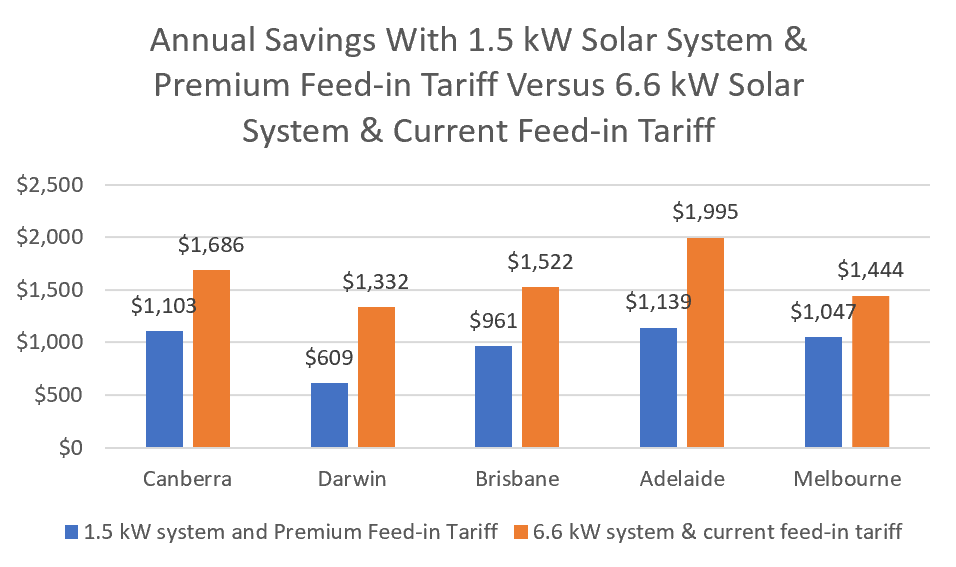
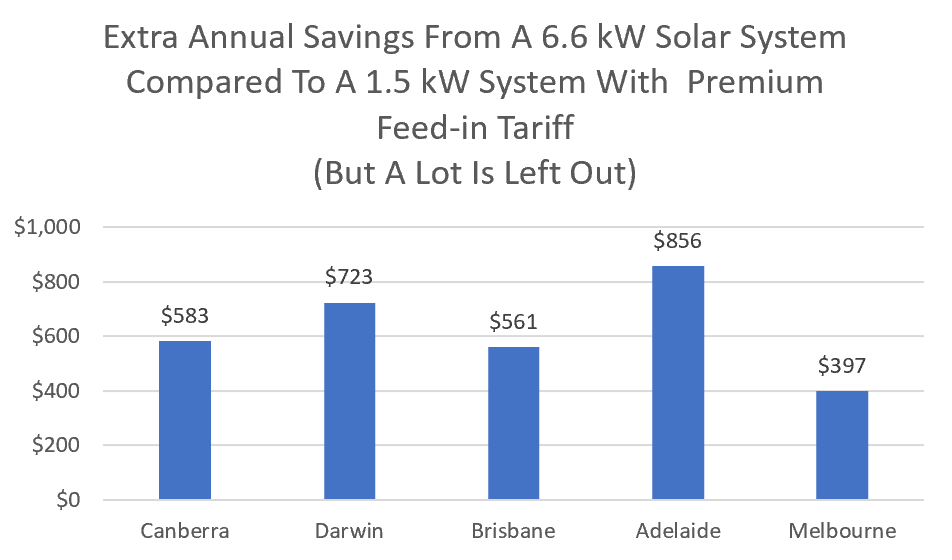
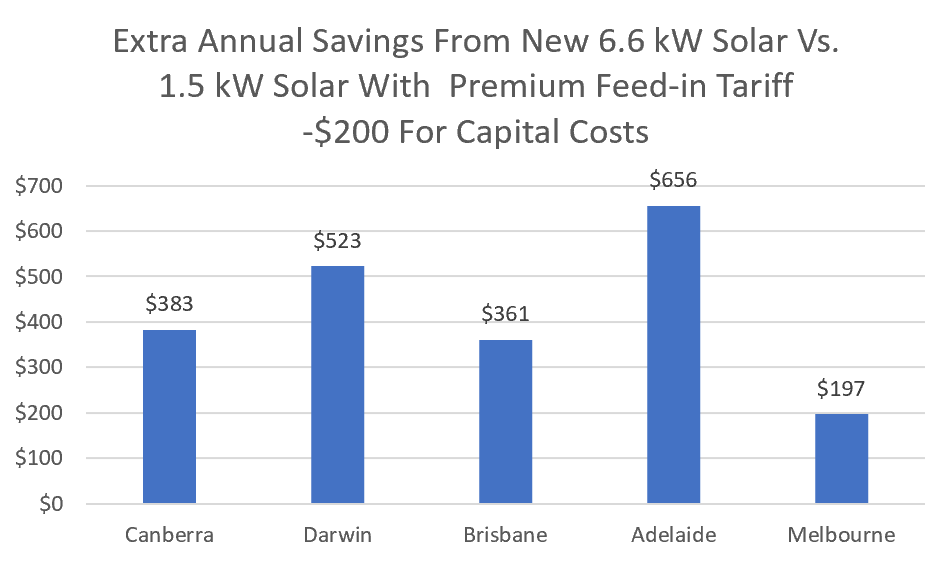
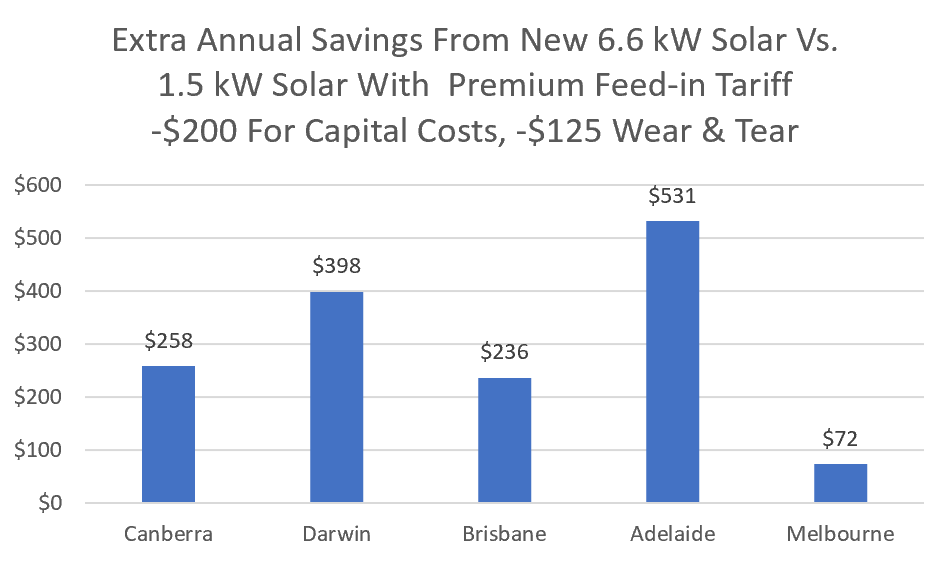
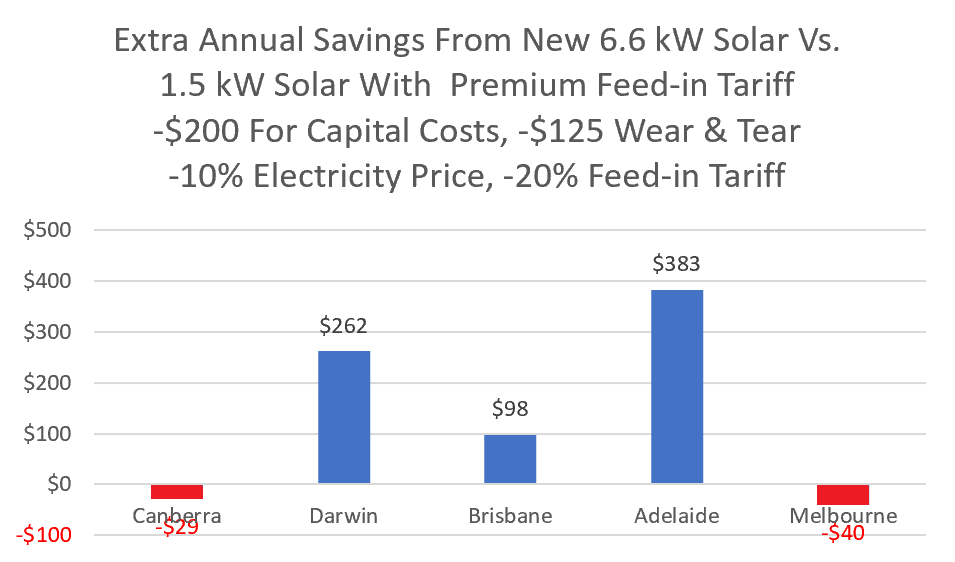
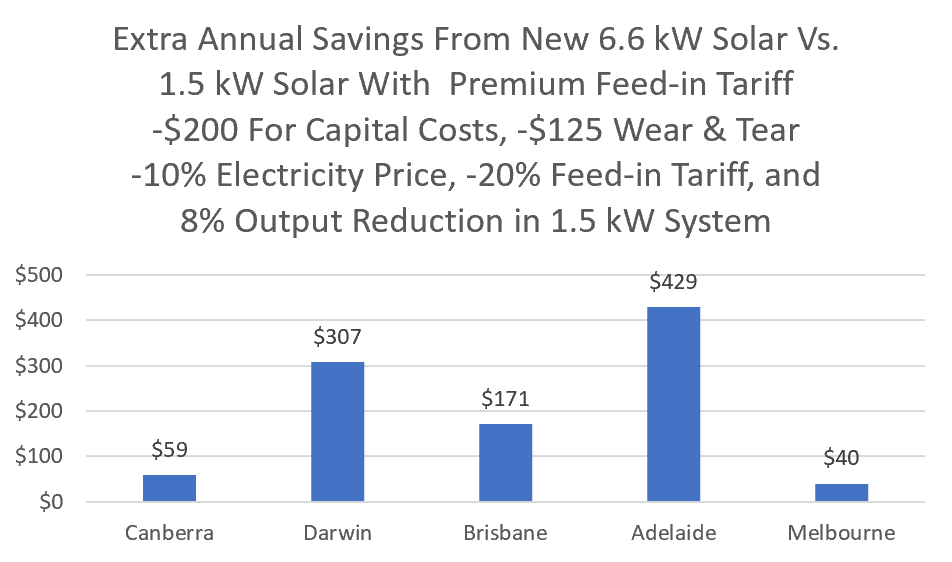
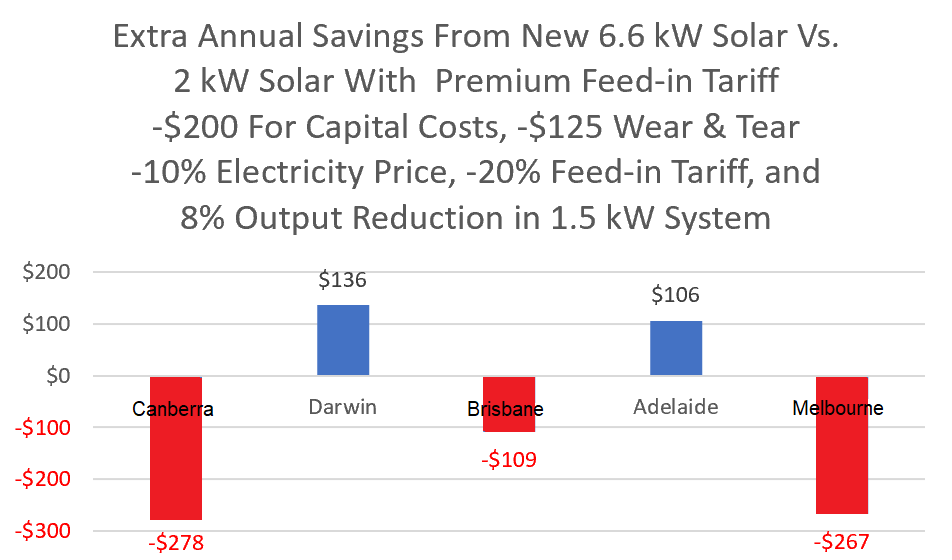
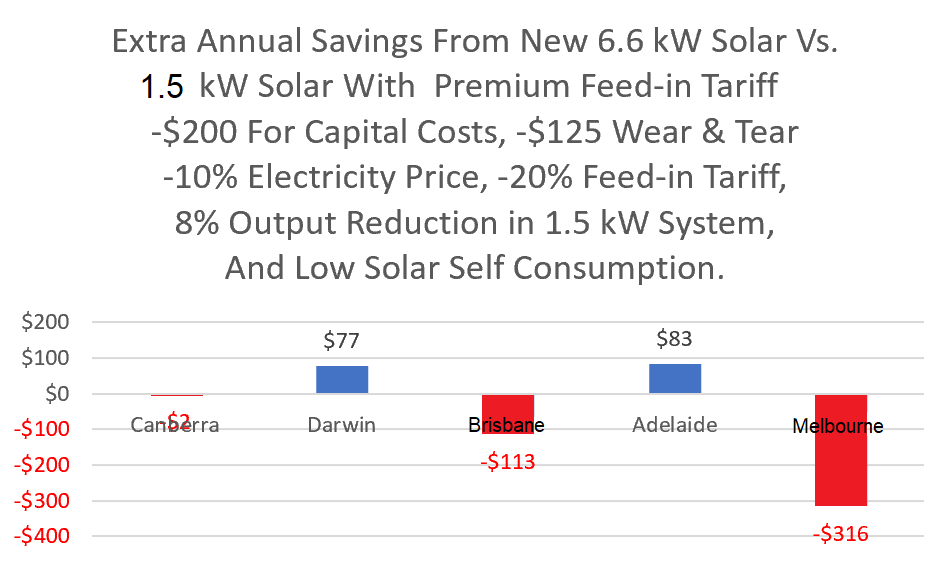
 RSS - Posts
RSS - Posts



The Northern Territory reduced the standard feed-in tariff from the lovely 1:1 to 8.5c/kWh in April 2020.
Existing systems are not affected by the change at the changeover date, but modifications and new installations are.
Yes all of these PFiTs are now closed off to new entrants and here in SA at least and upgrades negate the PFiT
Further to this. Any one buying a new home automatically get the new tariff too. As this is consider a change.
The home I bought in Alice Springs has an older 2kw system in place. But the output from the inverter is put on to the grid side. So I have to buy all my energy at the Jacana .25c/kw (approx) price. No such thing as solar self consumption here in the NT.
The cost to make the change to fix NTs Power & Waters penney pinching (they did not want to change the house Consumption meter to a smart meter) is excessive ($750;for the smart meter) plus what ever an electrician would charge (in my case it would be several hundred dollars to remove roof and re-wire from meter box to inside cct breaker distribution box.
So be a where people buying existing solar homes in the NT.
This is an irresponsible post imo. Don’t scrap the system. Try and reconfigure it with additional panels on a separate inverter.
I was advised that’s actually a _far_ more costly option, Tom. Environmentally, I agree with you.
Financially it makes no difference in WA, of course. We’re screwed.
As Ron notes:
“The possible(?!) exception is Western Australia where households with low electricity consumption may(?!) be better off sticking with a small system due to the low feed-in tariffs available for new solar in that state… “
Yep. I hate this whole idea of chucking out the old and buying the new.
Dumping what is otherwise a functional system is indeed environmentally irresponsible.
It doesn’t really matter, as long as no-one has any children, and is indifferent to any other species of animal.
We get a bit excited when we find some ceramic shards from the Qing dynasty or the Roman Empire. It’s not going to be like that in a couple of thousand years, when they’ll be swearing and cursing at our late-20th-century dynasty every time they try to dig a hole or go for a swim.
When I replaced my old system I didn’t want the old panels going to land fill so I used them for a shade roof over my chook shed,
What I would like to see is that old panels be tested and stored until enough are available to install systems on school building etc with no cost for the panels or other government buildings.
In most cases adding on to or modifying the system voids the original high FiT. When most of these systems were installed panels averaged 180W – now we’re double that so you can make much better use of the available roof space.
And you can sell your old panels like I did so they don’t go to scrap.
Upgrading in SA you lose the PFiT
Also as Ron points out you get more power per panel these days and roof space is an issue for many
I also understand there is a market for used panels. Some going OS and others being repurposed for pumps etc.
I thought we were lucky in SA with PFiTs but it appears we are not so special!
Due to our asbestos roof I hadn’t given much thought to replacing our 2.5kWp system. 1kW installed around 2000 and the second array in 2008
As you point out, the PFiT is a great incentive to export as much as possible and for some of us, to use as little as possible. We use 4kWh per day which really makes upgrading not financially beneficial
I guess I will just stay put until 2028 😉
It would be touch and go whether the numbers work out as suggested. 2011 and earlier vintage installations in SEQ are still paying up to 59c FiT, four times the currently available maximum of 15c. Certainly the amount of electricity exported and hence the yield would increase with a 6.6kw system as opposed to a 1.5kw system, but the cost of funding the upgrade would consume the additional return. IMO, the only way the proposition would be cost-effective is if the inverter and / or panels carked it. I wouldn’t be inclined to spend a lot on an aging system, far better to upgrade in that situation. One can never predict what governments will do in the future, at least the 44c is fixed for another seven years. Better a bird in the hand IMO.
Leave your old system going for FIT and fit a new one with batteries that does not feed to the grid. Keep your FIT and still have grid back up.
This will pay for your new system.
I’m not sure how they track it in the new world but here in SA, SAPN have a minimum grid take of 400kWh per year for PFiT solar customers
I took 643kWh from the grid in 2020 so the idea of taking some of my house off grid is not very appealing
I did consider doing it on a small scale for the fridge
I’ve taken our solar HWS boost off grid
Sorry but there are multiple incorrect assumptions used in the article which results in its conclusions being meaningless.
One of the most glaring is the assumption about self-use for a home.
If a house with an existing 1.5kW system only self-consumes 50% (assumption made) then logically if it were to install a 6.6kW system then its self-consumption could NOT be 30% (as used in many of the calculations.
It would be 1.5/6.6 x 50% = 11%
Using 30% certainly makes things look much better & will generate lots of business if anyone is foolish enough to believe the article – a bit like those who claim that household batteries are a great financial investment (for the suppliers & installers maybe).
Dissapointed to see such a ‘fake news’ article.
Neither electricity consumption or solar output are constant so solar self consumption does not change with system size in the way you suggest. If any other assumptions in the article are incorrect, point them out and I will update the article. I’ll appreciate it because having an article with mistakes in it makes me look stupid.
If a household is only able to self-use 50% generated from a 1.5kW system then how can its self-consumption TREBLE as is the assumption you use in your calculations?
If they do not have suddenly have a trebling in demand then their self-consumption will not change – certainly not increase by 3x what it was.
I am getting 14 cents per k
Just wondering if there are any safe recycling options for old solar panels.
Thanks
The good news is, solar recycling is coming to Australia:
https://reneweconomy.com.au/australias-first-solar-panel-recycling-facility-to-be-established-in-adelaide/
But as mentioned, provided they work you can often find someone who’ll take them. Just note you won’t be able to get much money for them.
Thanks very much Ron,
My 3kw system still has a few years to go may be more. Good to get some info now with the hope of improving out-comes in the future re clean and safe recycling.
Aectodally put it on Gumtree or FB and don’t ask for too much
I did exactly this about 12 months ago. I had installed a 1.1kW system about eight years ago and was still getting about a 55c feed-in tariff here in QLD. I left the old system in place and added another 6.6kW, giving me a total of 7.7kW. I had to limit output to the grid to 5kW, but with airconditioners, computers, fridge, and so on I easily use that 2.2kW difference myself most of the time, and of course solar never actually reaches its theoretical maximum.
Prior to the upgrade I was seeing $200+ bills per quarter, but even after having gone from 55c feed-in to about 19c now I haven’t seen a single bill in the year since then, and I’ve already had over $700 in payouts from the power company… and that’s after adding a 6kW air conditioner that’s in use most days for many hours at the same time as the solar went in. From my calculations it should have paid for itself in 3-4 years, and everything after that is just cream.
Looking forward to batteries becoming more affordible.
I had a 2Kw system on PFiT and replaced it with a 6.6Kw system in early 2019. I wanted to leave the old system in placed and just add the 6.6Kw system but was told that it was permitted in SA. I didn’t think that sounded right as I thought that export limiting was an option. I was also told that the Tesla Powerwall 2 could not handle inputs from both the old and new systems, which I also thought didn’t seem right. As there was too much else going on in my life at the time I let my unease go and simply replaced the old system with the new, together with the Powerwall 2.
Does anyone have any thoughts/views/information on the advice I was given regarding the old and new systems not being able to co-exist for a SA installation, and also about the Powerwall 2 not being able to handle both inputs ? In any event, even if that advice was wrong, I would a little wiser … and others who are contemplating what I had intended will benefit from a clarification of what is/isn’t possible to do in SA.
Thanks in anticipation to anyone who is better informed than I.
PS.
I gave the old system to a relative who used it in an off-grid installation. (I was told it couldn’t be used in a grid-connected installation because the components were no longer approved for such installation by the regulator.)
Correction; that should be “but was told it was NOT permitted in SA” in relation to having both the old and new systems connected to the grid.
You haven’t mention what to do in WA. I have had 3.6kW system for 10 years and its coming out of contract in July. What are the options for WA?
Hi Gary
Because the WA feed-in tariff for new solar is so low and because your system is fairly large for one that was receiving a premium tariff, you may be better off keeping what you have or at least waiting until it has a problem before replacing it. But it will depend on your electricity consumption. If it’s high enough it could be worthwhile to go bigger. This article goes into detail:
https://www.solarquotes.com.au/blog/solar-worth-it-perth/
Great Read,but where the sunshines in WA its a pity you have not included
very much.I run a 2.3kw system al good but with my tariff now reduced to 7c/k I am wondering if a new system is worth it and I am going to buy a system for my daughter and wonder if that is worth it.
cheers
Hi Mel
WA has the cheapest solar in Australia, so it can definitely still be worth it. But if your household electricity consumption isn’t high you may be better off sticking with your 2.3 kilowatt system if it’s functioning acceptably.
A new system for your daughter can definitely be worthwhile. Due to the low feed-in tariff for new solar some people will only put in a small system, but I advise people to at least consider putting in a 6.6 kilowatt system to future proof the home so they’ll be ready for a battery or an electric car. I also recommend it if the home doesn’t have gas or if they might go off gas in the future.
This article goes into more detail:
https://www.solarquotes.com.au/blog/solar-worth-it-perth/
Hi Ron.
You made no mention if the solar panel home owner lives in Sydney where the tariff now after 10 years is now only 7c/ kwh.
Please tell me why I should replace my 2010 installed 1.5kw solar panel (which still gave me 160 kwh for a period of 90 days) together with a working SMA inverter.? Never mind the current feed-in tariff.
Am I not better off waiting for one of them to break down before replacing them?
Hi Charles
Financially you will be much better off replacing your old 1.5 kilowatt solar system. Generally speaking, I’d recommend as large a one as you can reasonably install, but what is best for you will depend on your specific circumstances. If you wait until it breaks down and it breaks down in two years time, you’ll miss out on the savings you could have made in those two years.
Why have you not covered New South Wales in your article?
I have a 10 year old 1.5 kilowatt system and would not mind upgraded or replacing with a 6 kilowatt system.
Hi Wolfgang
NSW’s high premium feed-in tariff ended several years ago, so it will definitely make financial sense to replace an old 1.5 kilowatt system with something considerably larger. Note it is much easier and cheaper to replace an old system than upgrade it.
Hi, I have a 3kw system which was installed in 2010 in NSW. The inverter has just stopped working. I was told that to replace the inverter and bring the system up to code would be as expensive as replacing the whole system. I am in the process of getting quotes for a new 6kw system. I don’t use a lot of electricity and monthy bills vary from zero to about $15.
My current feed in tarrif is 19c (originally 66c but alas, no more). I am assuming this would drop quite a lot if a newer larger system was installed.
What should I do? Any advice appreciated.
Hi Sue
In your situation, given the limited information I have, I’d say it’s very likely you’d be better off replacing the old system with a larger new one that will be covered by a new set of warranties. While the solar panels could still be in good condition after 13 years, its definitely possible they’ve developed problems. Especially if they weren’t from a quality manufacturer to begin with. My normal advice is to install as large a solar system as you reasonably can. Even if it’s larger than you think you’ll need this will need it will future proof your home for when you get a battery or an electric car. But what’s best for you will depend on your circumstances, so please feel free to ask if you have any questions.
If you’d like to get quotes for a new system through us you can do that here:
https://www.solarquotes.com.au/quote/start/
Just enter your postcode and answer the questions that come up as best you can. We’ll only refer installers who do good quality work, even if you request a budget system, and we back them up with our Good Installer Guarantee:
https://www.solarquotes.com.au/installation-guarantee/
OK, thanks Ron.
Interesting, my problem is less about feed in because of NSW, it is about, more output. 6 years ago a 4.5kw system was installed works well, low light performance could be better, however nowhere near enough we consume anything from 15kw to 70 kw per day. So looking at a 10kw system that means tearing out the old one for the best panel orientation. Or leave it going and add a new 10kw or less but with less ideal orientation?
With your high electricity consumption I recommend installing as large a solar system as will reasonably fit on your roof. Provided you have 3 phase power, installing a large system should not be a problem. I definitely recommend going as large as you can because in the future you’ll be able to get a battery and you may get electric cars.
Removing a 4.5 kilowatt system that is only 6 years old and still working fine is a shame, but given that a 14.5 kilowatt system often doesn’t cost a great deal more than a 10 kilowatt system, replacing the old system with one large new one with new components and a fresh set of warranties is often going to be the best option for a high electricity consumption household.
Great article as it tackles questions no one else does regarding upgrading systems.
However the article mentions replacing a small old system with a large new quality one that will get you decades of use.
I see most of us early adopters replacing only a 10 years old system, so I doubt we would be keeping a new system for decades with all the advancements in technology and reducing prices of tech.
If we are replacing a 10 year old system I’d suspect in only 7 years to be replacing the next, which begs the question why bother with “quality”? I predicted this when I bought my 1.5kw system 10 years ago and went with the cheapest at the time. Two others I know of had to have the best quality system and paid a fortune, none of the systems broke down over the period and we are all looking at replacing them now.
Bottom line, the premium systems did nothing above and beyond then my cheap system other put them out of pocket significantly!
My 3KW single phase system has just come out of the 40c plus 7c per KW exported, I am in the process of replacing it with 10KW 3phase, the aim is to run pool, bore and A/c ( 3 phase ducted 7KW ) before 3PM, when Synergy only pays 3c/KW, then export as much as possible from then till sundown when they pay 10c/KW, to help that I will be facing some of the system west so it gets the maximum benefit from the setting sun.
You can use the old panels to power a solar pool pump, I have had one for a couple of years now and it works well
I’m going out on a limb here.
Solar feed in tariffs that exceed the current wholesale market price are completely immoral and a disgrace, they should be eliminated as soon as possible. Trust the ACT, where the whole place is just full of leaners spending other peoples money to have the most generous feed in tarrifs.
Home solar system installations are already heavily subsidised by the hapless taxpayer, why should additional subsidies be provided over the life of the installation.
Remember there are millions of Australians who will never be able to directly enjoy the benefits of this home solar “PV revolution”. These people include the millions of peope being shoe-horned into medium or high density appartment dwellings, where home solar PV is not practical, or the millions of often low income Australians living in rented accomodation. All of these people, many of whom are the most vulnerable, are subsiding the lucky “haves” who are able to have their own PV installation. The haves should enjoy the ecomomic benefits of their own self consumption, but any excess fed to the grid shouod be at the current wholesale NEM market price, nothing more, in the name of fairness and equality.
Unfortunately, this means FITs averaging 5c per KW/h or less (which equates to $50 MW/h on the NEM)
States such as ACT, QLD, VIC and SA that are still paying FITs around 50c (ie $500 MW/H ) have a lot to answer for in allowing this economic injustice to perpetuate..
All of these schemes closed to new entrants years ago
Those who have them have ironclad contracts
Maybe find some different clouds to yell at
The earlier 1.5 Kw system FIT’s were rather generous (depending on what state you lived in of course), But that may reflect attempts by government to establish a brand NEW industry and ‘help it get on its feet’ by ‘subsidizing’ it in some way during its infancy years.
Lack of industry diversification was far more of problem for QLD 10 years ago than it is now, (although it still is a major one today and was, even before COVID).
A 1.5 KW system, at best, only generates a daily annual average of around
4..7 kwh per day and much of the year only a small part of that would get exported anyway, because you can’t run an average Australia household that needs 15 or so kwh per day on 5 kwh per day. . During winter, even in QLD you ‘would;ve been be lucky to export 1 or 2 kwh a day. Turn on your single bar 1 kw bar heater for more than 2 hours then there’s not much left to export.
But now that larger PV systems are available, many households with panels are now indirectly subsidizing non-solar PV owners. (or should be).
Here;s why. If a solar system householder is receiving (say} a 10 cents FIT, and the retailer is ‘on-selling’ that to other householders at 25 cents, then clearly there;s some room there for the retailer to reduce the price for non-solar PV owners. That’s quite apart from any other margins that might be floating around in some mystical accounting provisions and practices.
So I’,m afraid I pretty much disagree with the conclusion that low income earners are ‘subsidizing’ supposedly wealthy solar PV system owners. Most of the time its’ really the other way around. Or it would be if we stopped spending billions on keeping coal powered generating stations open,
A mere $1 billion dollars would go a very long way towards installing household solar PV systems on the roof’s of around 200,000 households.
The need to take care of the more vulnerable has only begun, belatedly, to be recognised by some states as we know, through the gradual introduction of assistance to low income earners to purchase and have installed a modest solar PV system. More recently we’ve also seen the introduction of rather modest annual direct credits against low income family’s power bills.
But its all been the usual case of too little, to late. As you rightly point out those who don’t own their place of residence have been left far out on a limb.
But lot’s of home owners aren’t on ‘easy street’ either. There;s also an increasing number of people, including those, who DO own a home finding that after paying their rates and power bill, they have major problems meeting their mortgage commitments.
Dont forget, lots of homeowners skimped and saved for years to accumulate enough for a home deposit, and many are still paying off their mortgage 25 or 30 years later.
I’m not saying the ‘vulnerable’ aren’t disadvantaged, they are. But don’t lay the ‘blame’ for that on the heads of what are often struggling home-owners. Local councils, and greedy developers, along with massive under-funding by successive governments to address the needs of disabled people and the housing needs of low income earners have had a far more significant impact.
.
I agree that still
.
What about Hobart? No mention!
Hi Is there any reason why you never use any stats from WA?? Considering the amount of solar installed in WA it would be great to hear more and see the data concerning WA not just the other states.
Cheers
WA’s premium feed-in tariff has already ended for most who had it and will be completely finished in a few months. No premium tariff would usually mean it would make sense to replace an old 1.5 kilowatt solar system with something much larger. However, do to the very low feed-in tariff for new solar in Western Australia some people with low daytime electricity use may be financially better off sticking with their small system. On the bright side, Perth has the lowest cost rooftop solar in Australia, so that does help. I wrote about the payoff periods for rooftop solar in detail for WA here:
https://www.solarquotes.com.au/blog/solar-worth-it-perth/
Basically, if there are typically people at home during the day or en effort is made to shift consumption to the day, such as by putting a pool filter or electric hot water heater on a timer, then a larger system can make sense.
I’m in W.A., and my premium payments for exporting power from a 3kw system, 47c/kwh has just ended, back to 7c, so I have fitted a 8kw 3 phase system, but as Western Power will not pay anything for power from systems over 5kw, we accepted that and try to do as much power usage when the sun is up, I faced half the panels NE, and half NW so we are getting output virtually all day.
I have a battery pack going in soon, hopefully that will cover most of the power use when the sun is down.
I am still getting a good FiT in the Northern Territory, but I agree with the principle. I have just installed 30kWh of batteries, and after they’ve been running for a couple of months, I should be able to determine how many additional batteries I am able to charge with my 15,735W on the roof. I’ve been told that my little roof is full, but I’m not convinced – I reckon I could squeeze more kW up there.
My intention is to feed my limit of 5kW to the grid day and night, in addition to having my own backup energy and UPS.
We wouldn’t need to make do with the unreliable, expensive, and destructive centralised generation at all if we we were able to upgrade our old chug-a-lug energy grid to a distributed system and thus get inexhaustible, uninterruptible, zero-marginal-cost energy into the ‘burbs.
Hi Greg
How much did your 30 kWh of batteries cost, and what is your average cost of grid power in NT?
I am looking at batteries for my own place, but I can never make the numbers stack up.
For example, in Sydney I pay 24c kw/h with a 9.5c F.I.T. Most battery quotes are around $1000 per kw/h of storage. For a typical life of 4000 charge/discharge cycles, you can only cover around 60% of the outlay of the battery through grid savings, for me its just not worth the cost…
Not sure your logic is correct about the pool pump (not filter as the pump drives the water through the filter inmy experience filters are purely passive systems – not with their own power supply).
Possibly correct if an old single speed pool pump – if anyone still uses one then replace it ASAP. Running a pump at 100% power (what a single speed pump does) is a little like driving in 1st gear at 110 km/h
Installing a variable speed pool pump with 2x the power (HP) capacity of the minimum required for a pool will see total electricity consumption fall to around 1/8th that of the 1/2 capacity variable speed pool pump.
Seemed too good to be true, so I did major due diligence prior to purchase, but it is correct. Total kwhs used per day fell to just over 2 kWhs from over 8 kWhs with the old variable speed pump – running for 10 hours per day from 8am to 6pm. This powers the pool vacuum & pool filter the entire time. Crystal clear water.
Would not like to hazard a guess on how much electricity a single speed pump would have used.
This is for a very large (by residential standards) pool with a 8 foot 9 inch deep end.
As others have said, consider adding a 2nd system rather than replacing.
My family’s house had a 1.5kw inverter and 2kw of panels.
The solar company had suggested removing the old system. I advised against it.
Queensland had recently raised inverter limits to 10 kw per phase (5kw export limit per phase). The family home was connected to 3 phase power already for the air conditioner.
We installed a new 10kw 3 phase inverter, and 10kw of panels. And we kept the old system making for 12kw total.
The losses from panels not facing the ideal direction are 10, maybe 15%. Trivial imo. 10 additional 350w panels facing north (compared to any other direction) replacing the old 180w, might give us 30w extra gain per panel * 10 = 300w. We installed the entire new system facing west.
The only reason I’d consider replacing an old system is if the entire roof were already full. Then replacing 170w panels with 350w may be worth it.
30 years is simply when a systems production has degraded significantly (perhaps 20-30% if it is still operating). I’m happy to leave our small 1.5kw system going until the inverter fails. Thankfully, the Fronius board failed on year 9 of our 10 year warranty, so I’m hoping the repaired inverter will be good for another 10.
Unless you are out of roof space or are bumping up against the inverter limit, why replace the old system?
I really do hope if our 10kw inverter fails in 10 years, we can replace it economically and keep the existing panels.
At some point I’ll be examing if we can add a 3rd system as we still have roof space.
Also, have run the numbers on batteries many times and the return rates are simply too low. Powerwall 2 pays for itself in like 20 years.
Solar panels pay for themselves in less than 2 years. I’d rather have 30kw of panels, even limited to 15kw export, than waste any of my inverter limit on batteries (at today’s prices). If the backup ability of the Powerwall is valuable to you, then that does change things. It really sucks that batteries count against your total inverter limit in Qld. Hopefully these bottlenecks get removed as the grid is upgraded to deal with electric vehicle charging.
Just get a 12.6kw system in Qld even if you’re on single phase. Yes 5kw export limit. But some power will be self used, and you will export a lot more power on cloudy days, and in the early morning and late afternoon when the system isn’t running at peak.
Alinta Energy export is at $.11, and general tariff is $.16. Grid export is still the best battery, for now. When the price of Powerwall 2 13.5 kWh drops from $13k to $6.5k, batteries may start to stack up increasing the return from 5% a year to 10%.
I drive rideshare so will eventually switch to an electric vehicle and toss the biggest solar system I can on the roof around 2025. Evs like batteries are just too expensive still for the economic case to stack up yet. But in a few years, that is all supposed to change as battery prices plummet.
Another thing you can do with evs is charge them with an overnight tarrif. For Alinta anyway, this power costs $.135, further shrinking the gap compared to the $.11 export. So for now, the grid export will be my “battery”.
I am in the process (have ordered) of installing a new system of 13.2 kW. to replace the old 3 kW system. I don’t have the Premium Qld bonus FiT.
However, I am worried about reading about “Export Restrictions”. I have never heard of a limit. How much is it and should I be concerned? We don’t use much electricty.
Hi Grace
If you have 3 phase power there should be no problem and you should be able to export all the surplus energy your solar inverter produces. If Energex or Ergon won’t allow you to export the full amount, your installer should inform you of this before they go ahead.
If you have single phase power then there will be an issue and your installer should have definitely discussed this with you. (If you’re not sure if you have single phase or three phase power, let me know and I’ll help you out.)
Des, there is some curious circular logic in your arguments there, and i’m not sure how you come to the conclusion that the solar “haves” are some how subsidizing the solar “have nots” by way of the difference between the solar fit and the standard retail rate. What matters is the difference between the fit and the wholesale electricity rate. When the fit is higher than the wholesale rate which is pretty much 100% of the time even with sub 10c fits, then the have nots are subsidising the haves, whatever way you look at it….
Not quite as easy as you may think.
There are a few other factors (costs) that come into the equation to work out net cost/benefit.
For example:
# Transmission losses – solar produced by your neighbour can be used by you & has close to a 0.00% transmissin loss vs bringing it from up to several thousand km away.
# Having local power generation (roof top solar) reduces the need to upgrade transmission lines, towers, and multiple substations for stepping down the voltage.
# As solar power is produced generally at the same time as existing gas or coal powered stations are suffering from high heat days (& risk of going offline as has been happening more than weekly for the last few years) – your neighbour’s panels are both lowering the overall cost & increasing system stability & dependability aka reduces load on the fossil fuel power stations therefore lowering risks of failures & blackouts. If there weren’t the roof top systems then outages were estimated to likely have been 2 to 3x more frequent & leading to up to 12x more extended black outs.
These are just some relatively quantifiable benefits above just the price differential.
Others would like to put a price on decreased particulate emissions etc.
We are in NSW with a FIT of 11.1/kw
We installed a 2.5 15 panel ‘ECOKES system in 2010
We upgraded to a Fronius 3 kw inverter in 2015
Is it now time to consider replacing this system with a 6 kw system or higher given that pricing is so much lower with energy costs much higher.
Are seeing ads from one company to trade in old panels for up to $1000 for 14 or more panels
Also will we negate our FIT by replacing
Here goes:
…We are in NSW with a FIT of 11.1/kWh
…We installed a 2.5 15 panel ‘ECOKES system in 2010
…We upgraded to a Fronius 3 kw inverter in 2015
Is it now time to consider replacing this system with a 6 kw system or higher given that pricing is so much lower with energy costs much higher.
If you’re in NSW – I am pretty sure that energy costs have fallen (per kWh) since 2015… Or at least they have for us.
So I checked our bills. (All include GST)
2014 27.39 cents per kWh Daily supply charge = 78.10 cents/day
2015 26.69 cents per kWh
2021 21.44 cents per kWh
2022 20.56 cents per kWh Daily supply charge = 75.24 cents/day
If you have the roof space that will take the additional panels you then have two choices.
1) Have two separate systems feeding into your meter.
2) Add the 6.6 kWs panels, but increase the capacity of the new inverter to handle both the new 6.6 kWs and the old 3 kWs.
Your existing inverter is from a ‘good’ manufacturer – chances are it has at least 3 to possibly 7+ years life left in it. Keeping it & the 3 kW panels (if roof space permits) gives you the best of both worlds.
Almost like a free option – to put off the decision of getting rid of the old panels at only 1/4 to 1/5th of their 80% generation life time.
Remember panles developed by UNSW in the 1970s are still generating power today.
…Are seeing ads from one company to trade in old panels for up to $1000 for 14 or more panels
Almost sounds too good to be true – so it probably is. I could be wrong but it sounds like a wrinkle on the ‘Bait & Switch’ con.
You get offered something really good (too good?) & it clouds your judgement on everything else to do with the deal – such as final total cost.
Most common example these days are the Private Health Funds offering ‘deals’ to get you to switch. Trouble is for most – the following few years see your plan’s premiums increase at up to 4x as much as the quoted ‘avg increase’ for that company.
BOTTOM LINE: Check the details to the decimal point. Exactly what brands are used for the new install, what wattage per panel etc.
…Also will we negate our FIT by replacing
Most unlikely but check on your provider’s web site, & if still in doubt then call them up and pretend you’re a prospective customer. Note down the date, time & who you’re speaking to, length of call & any relevant info you’re told. Ask if in a year or two you increase your rooftop solar – if that alone would impact the FIT you would get if you switch to them.
Acknowledge that FIT rates can be changed at any time, with notice, by the provider notwithstanding.
PS: The size of the FIT is not the relevant figure to consider.
The key figure (for most) is the difference between what you pay for grid-sourced electricity vs what you get for the FIT.
In our case the best offer (with our latest switch) had a difference of just over 9 cents per kWh.
If you have basic spreadsheeting skills (able to multiple one cell by another) then the best way is to create a simple spreadsheet to compare various offers.
You have rows for each component of the offer (total grid kWh cost, total FIT, total daily access fee) & your current plan. Then you have columns for a number of past power bills. You enter the details from each bill at the top of each column (their own row each – number of days, Grid kWhs used, FIT kWhs sent to grid).
At the very top left you have the constants (per Grid kWh cost, per FIT kWh received, daily access fee).
Then just a matter of putting the formula into each ‘calculating row’ for each component.
Simplest (if you know what you’re doing) next step once your calcs produce the same figure as your bills – is to copy the whole thing down below itself to create your comparison for offers.
Just need to edit the 1st column of calcs to adjust the source of the ‘constants’ from say B$3 to B$23, B$4 to B$24 etc, Copy this updated column across to the other period columns – and see if you get the same totals as above.
If so, then adjust one figure (say daily access fee) by some amount and see if the totals change….
Hi John
The $1,000 trade in for old panels is a sales tactic and they will make up for it in the cost of the new system. If they didn’t, they’d go out of business. There’s no longer any premium feed-in tariff in NSW to lose by installing a new system, so your feed-in tariff will be what you can get from your electricity retailer and, at the moment, can be up to 13 cents. But if you don’t have a smart meter already one will be installed and you will normally be put onto a time-of-use tariff and retailers can make it difficult to change back to a flat tariff if that’s what you prefer. Upgrading to a larger system definitely can pay, but whether an individual will consider it worthwhile will come down to personal preferences. If you decide to get a new system, I highly recommend using an installer who does quality work. If you like you can get quotes through use and we will only refer you to installers we know take pride in their work:
https://www.solarquotes.com.au/quote/start/
Hi Ronald,
I have referred to this article a couple times and was wondering whether there might be an update in the wings?! I am in SA on the 44c FiT with a 3.6kW system installed in about 2011. As energy prices have change and FiT has reduced I am noticing I seem to be paying more than receiving credit!
Thoughts?
Cheers
If you are only paying a modest amount more than you are receiving in credit, then you are not doing too badly. It sounds like your electricity consumption isn’t very high, given current electricity prices in Adelaide. But, given we are expecting huge hikes in electricity prices in the middle of next year, I definitely recommend considering a larger system. Without knowing your details I can’t say if you’ll definitely be better off, but it bears looking into.
It probably does make sense to update the article. One thing that isn’t clear is just how much electricity prices will increase next year, but I can use a reasonable estimate.